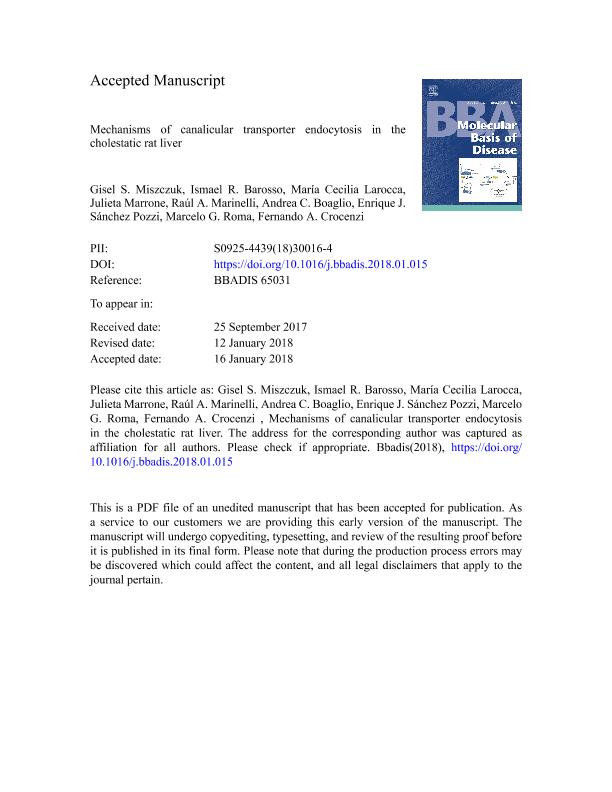Artículo
Mechanisms of canalicular transporter endocytosis in the cholestatic rat liver
Miszczuk, Gisel Sabrina ; Barosso, Ismael Ricardo
; Barosso, Ismael Ricardo ; Larocca, Maria Cecilia
; Larocca, Maria Cecilia ; Marrone, Julieta
; Marrone, Julieta ; Marinelli, Raul Alberto
; Marinelli, Raul Alberto ; Boaglio, Andrea Carolina
; Boaglio, Andrea Carolina ; Sanchez Pozzi, Enrique Juan
; Sanchez Pozzi, Enrique Juan ; Roma, Marcelo Gabriel
; Roma, Marcelo Gabriel ; Crocenzi, Fernando Ariel
; Crocenzi, Fernando Ariel
 ; Barosso, Ismael Ricardo
; Barosso, Ismael Ricardo ; Larocca, Maria Cecilia
; Larocca, Maria Cecilia ; Marrone, Julieta
; Marrone, Julieta ; Marinelli, Raul Alberto
; Marinelli, Raul Alberto ; Boaglio, Andrea Carolina
; Boaglio, Andrea Carolina ; Sanchez Pozzi, Enrique Juan
; Sanchez Pozzi, Enrique Juan ; Roma, Marcelo Gabriel
; Roma, Marcelo Gabriel ; Crocenzi, Fernando Ariel
; Crocenzi, Fernando Ariel
Fecha de publicación:
04/2018
Editorial:
Elsevier Science
Revista:
Biochimica et Biophysica Acta - Molecular Basis of Disease
ISSN:
0925-4439
Idioma:
Inglés
Tipo de recurso:
Artículo publicado
Clasificación temática:
Resumen
Impaired canalicular secretion due to increased endocytosis and intracellular retention of canalicular transporters such as BSEP and MRP2 is a main, common pathomechanism of cholestasis. Nevertheless, the mechanisms governing this process are unknown. We characterized this process in estradiol 17 β-D-glucuronide (E17G)-induced cholestasis, an experimental model which partially mimics pregnancy-induced cholestasis. Inhibitors of clathrin-mediated endocytosis (CME) such as monodansylcadaverine (MDC) or K+ depletion, but not the caveolin-mediated endocytosis inhibitors filipin and genistein, prevented E17G-induced endocytosis of BSEP and MRP2, and the associated impairment of activity of these transporters in isolated rat hepatocyte couplets (IRHC). Immunofluorescence and confocal microscopy studies showed that, in E17G-treated IRHC, there was a significant increase in the colocalization of MRP2 with clathrin, AP2, and Rab5, three essential members of the CME machinery. Knockdown of AP2 by siRNA in sandwich-cultured rat hepatocytes completely prevented E17G-induced endocytosis of BSEP and MRP2. MDC significantly prevented this endocytosis, and the impairment of bile flow and biliary secretion of BSEP and MRP2 substrates, in isolated and perfused livers. BSEP and MRP2, which were mostly present in raft (caveolin-enriched) microdomains in control rats, were largely found in non-raft (clathrin-enriched) microdomains in livers from E17G-treated animals, from where they can be readily recruited for CME. In conclusion, our findings show that CME is the mechanism responsible for the internalization of the canalicular transporters BSEP and MRP2 in E17G-induced cholestasis. The shift of these transporters from raft to non-raft microdomains could be a prerequisite for the transporters to be endocytosed under cholestatic conditions.
Archivos asociados
Licencia
Identificadores
Colecciones
Articulos(IFISE)
Articulos de INST.DE FISIOLOGIA EXPERIMENTAL (I)
Articulos de INST.DE FISIOLOGIA EXPERIMENTAL (I)
Articulos(OCA PQUE. CENTENARIO)
Articulos de OFICINA DE COORDINACION ADMINISTRATIVA PQUE. CENTENARIO
Articulos de OFICINA DE COORDINACION ADMINISTRATIVA PQUE. CENTENARIO
Citación
Miszczuk, Gisel Sabrina; Barosso, Ismael Ricardo; Larocca, Maria Cecilia; Marrone, Julieta; Marinelli, Raul Alberto; et al.; Mechanisms of canalicular transporter endocytosis in the cholestatic rat liver; Elsevier Science; Biochimica et Biophysica Acta - Molecular Basis of Disease; 1864; 4; 4-2018; 1072-1085
Compartir
Altmétricas



